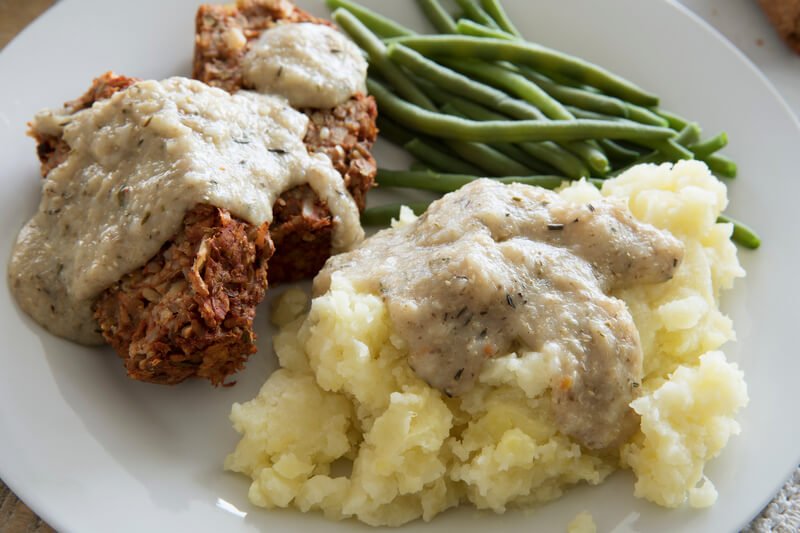If you’ve recently been switching out cow’s milk for non-dairy milk such as almond milk you may be concerned over how many recipes you will have to give up. A common question people have is if almond milk is a viable substitution for recipes that need to thicken, such as gravy. Are you wondering if it is possible to make gravy with almond milk?
The great news is that it is definitely possible to make gravy with almond milk. In fact, it is likely much easier than you might think, despite the consistency and taste difference between the two milks.
This article is going to answer if it is possible to make white gravy with almond milk, how the recipe works, what type of almond milk to use, and will provide step-by-step instructions that are easy to follow.
Can You Make White Gravy With Almond Milk?
While there are many different types of gravy you can make with almond milk, the gravy we are concerned with for this article is white gravy.
White gravy is used in many different dishes from biscuits and gravy to chicken fried steak.
You can absolutely make white gravy from almond milk.
In fact, as far as substitutions go, almond milk is a great alternative for cooking if you are looking to avoid cow’s milk, heavy cream, or whatever form of liquid your original white gravy recipe calls for.

Related: Can You Cook With Almond Milk?
Do You Need to Change Your Recipe?
A basic white gravy recipe calls for:
- Oil
- Flour
- Salt
- Pepper
- Milk
The great thing about using almond milk as a substitution in most white gravy recipes is that you will likely not have to change the recipe you’re using at all!
Almond milk is a 1 :1 replacement for cow’s milk in gravy.
Since most gravy recipes already call for the use of a thickening agent, such as flour, that means you don’t really need to worry about the difference in consistency between almond milk and cow’s milk.
Therefore, if your recipe calls for one cup of cow’s milk you can substitute it with one cup of almond milk without any issue.
One thing to remember about cooking with almond milk is that you do need to watch it and make sure that it doesn't scorch on the bottom of the pan.
So you may need to stir more frequently than your original recipe calls for, but you won’t have to change any ingredients!

What Type of Almond Milk Should You Use to Make Gravy?
There are many different types of almond milk out there such as sweetened, unsweetened, vanilla, chocolate, etc.
While this may be obvious, the best almond to use as a substitute for cow’s milk in white gravy is plain unsweetened almond milk.
Plain unsweetened almond milk has the mildest flavor and can provide some of the same nutrients, with less fat and sugar.
In fact, one serving of cow's milk has 150 calories, whereas the same amount of almond milk only has 39 calories.
Almond milk also contains significantly less sugar—0 grams compared to the 12 grams in cow’s milk.
Cow’s milk does have more protein per eight ounces, eight grams compared to the two grams in almond milk.
However, almond milk is often fortified to include high amounts of calcium, vitamin A, and vitamin D.
Unsweetened plain almond milk will provide a similar profile, similar nutrients, and may even make your gravy slightly healthier due to the lower calories and fat content present in almond milk.
Related: Almond Milk vs. Cow Milk
How to Make Gravy With Almond Milk
We are going to go over the basic steps for making gravy using almond milk!
- Make a “roux,” which is the thickening agent for your gravy. To do this you mix equal parts of olive oil and flour with a whisk in your saucepan using medium heat.
- Keep whisking until the flour and oil have combined into a paste-like substance and the flour has completely dissolved.
- Add in your almond milk one tablespoon at a time, whisking after each addition until the gravy has reached your preferred consistency.
- Add your desired seasonings and whisk to incorporate. Consider adding salt, pepper, garlic/onion powder, herbs, etc.
- Serve immediately!

Some Tips and Tricks
While this a fairly basic recipe, we can provide some additional tips and tricks to make sure your gravy turns out just as yummy as you’re used to!
Consider adding butter to your roux in place of, or in addition to olive oil.
Butter will provide a slightly richer flavor, and there are many different vegan butters if you want to keep your recipe dairy free!
Make sure you don’t cook your roux too long.
If your goal is to make a white gravy, you shouldn’t allow your roux to start turning color before you add in your almond milk.
If this happens your gravy may turn into brown gravy!
And finally, if you want to add in some sausage pieces or ground beef to spruce up your gravy you should cook those separately and add them once the gravy is completed.
If you’re going for a vegan recipe, consider making a mushroom cream gravy or a pea gravy if you want to try something a little different!
Final Thoughts On Almond Milk Gravy
It is absolutely possible to make gravy using almond milk.
Almond milk is an incredibly versatile liquid and can be substituted into almost any recipe that calls for cow’s milk without any issues.
Almond milk will provide a similar flavor profile and create a less fattening gravy.
Although it is possible you may have to do a little tweaking depending on your personal taste, for the most part almond milk can be used as a 1 : 1 substitution in gravy.
Next time you make your white gravy consider making it with almond milk and see what you think! You may be surprised over how delicious this dairy-free alternative can be.
